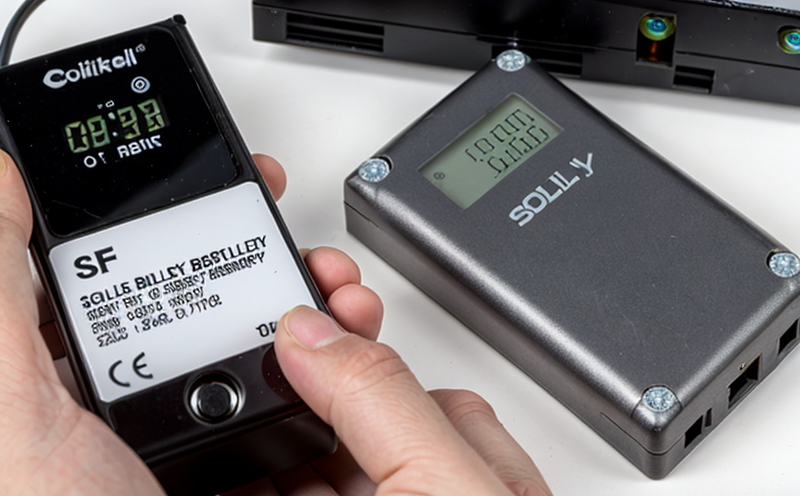ANSI C18.2M Solid-State Battery Testing for Secondary Portable Batteries
The ANSI C18.2M standard specifically addresses the testing requirements for solid-state batteries used in secondary portable devices such as laptops, tablets, and other rechargeable consumer electronics. This standard ensures that these batteries meet stringent quality and safety criteria to protect users and the environment from potential hazards.
Solid-state batteries are a significant advancement over traditional lithium-ion batteries due to their enhanced safety features. The solid electrolyte in solid-state batteries eliminates flammability risks, making them more suitable for portable devices where space constraints necessitate compact designs. This standard plays a crucial role in ensuring these advancements do not compromise the reliability or longevity of the battery.
The ANSI C18.2M test procedures are designed to evaluate various aspects of solid-state batteries, including their electrical performance, thermal stability, and durability under different operating conditions. Compliance with this standard is essential for manufacturers aiming to bring safe, reliable products to market while adhering to regulatory requirements.
Key parameters tested include charge/discharge rates, cycle life, impedance measurement, and internal resistance assessment. These tests are conducted using specialized equipment that simulates real-world usage scenarios, allowing for accurate performance evaluation. Additionally, the standard mandates thorough safety checks to ensure compliance with fire safety regulations.
The testing process begins with careful preparation of the battery specimens according to specified guidelines outlined in ANSI C18.2M. This includes ensuring consistent electrode surface area and thickness, which are critical factors affecting overall performance. Once prepared, the batteries undergo a series of tests aimed at assessing their operational characteristics under various stress conditions.
One notable aspect of this standard is its focus on durability testing, which involves exposing the battery to extreme temperatures and humidity levels typical in portable device environments. This helps identify potential weaknesses that could lead to premature failure or safety issues during use. Furthermore, the standard requires comprehensive analysis of both initial performance metrics and long-term degradation trends.
The results from these tests provide valuable insights into the suitability of solid-state batteries for specific applications within secondary portable devices. By adhering strictly to ANSI C18.2M standards, manufacturers can ensure their products meet industry benchmarks while maintaining high levels of safety and reliability throughout their lifecycle.
Industry Applications
The ANSI C18.2M standard finds application across various industries where secondary portable batteries are integral components. Notably, it is widely used in consumer electronics manufacturers who produce laptops, tablets, smartphones, and other personal computing devices. These companies rely on rigorous testing protocols to guarantee the longevity and safety of their products.
Additionally, automotive manufacturers incorporate ANSI C18.2M-compliant solid-state batteries into electric vehicles (EVs) and hybrid cars as part of advanced battery management systems. This ensures that EVs can operate efficiently while minimizing fire risks associated with conventional lithium-ion cells.
- In the medical device sector, ANSI C18.2M standards are employed to assess implantable devices powered by rechargeable batteries. Such stringent testing guarantees consistent performance and safety for patients relying on these technologies.
The aerospace industry also benefits from ANSI C18.2M compliance when developing avionics systems that require reliable power sources capable of withstanding harsh environmental conditions. By leveraging this standard, airlines can ensure their equipment operates safely even during critical phases of flight.
Quality and Reliability Assurance
Compliance with the ANSI C18.2M standard is paramount for maintaining high standards of quality and reliability in solid-state battery testing. This ensures consistent performance across all batches produced by manufacturers, thereby enhancing consumer confidence.
- Type Testing: Initial type tests are conducted to verify that each batch meets the specified requirements before production begins.
- Production Tests: Continuous production testing guarantees ongoing adherence to quality standards throughout manufacturing processes.
The primary goal is to identify any inconsistencies or defects early in the development cycle, allowing for timely corrections. This approach not only improves product quality but also reduces costs associated with rework and scrap.
| Test Parameter | Description |
|---|---|
| Electrical Performance | Measurements of charge/discharge rates, impedance, internal resistance, and cycle life are critical indicators of battery performance. |
| Thermal Stability | Battery specimens are subjected to temperature cycles ranging from -40°C to 65°C to assess thermal stability. |
| Impedance Measurement | Internal resistance assessment provides insight into the battery's health and potential for future performance degradation. |
Through comprehensive quality control measures, ANSI C18.2M helps ensure that solid-state batteries are reliable and safe for use in portable devices across diverse industries.
Use Cases and Application Examples
- Consumer Electronics: Compliance with ANSI C18.2M ensures that laptops, tablets, smartphones, and other consumer electronics have dependable power sources capable of delivering consistent performance even under challenging conditions.
- Automotive Industry: Electric vehicles (EVs) and hybrid cars benefit from ANSI C18.2M-compliant solid-state batteries integrated into advanced battery management systems to enhance efficiency and safety.
In the medical device sector, ANSI C18.2M standards are crucial for assessing implantable devices powered by rechargeable batteries. This ensures consistent performance and safety for patients relying on these technologies.
| Test Case | Description |
|---|---|
| Battery Cycle Life | Determines the number of full charge/discharge cycles a battery can undergo before its capacity declines significantly. A minimum cycle life of 1000 cycles is typically required. |
| Impedance Measurement | Internal resistance assessment provides insight into the battery's health and potential for future performance degradation. A maximum impedance value should be specified in the standard. |
The use of ANSI C18.2M in various industries underscores its importance in ensuring that solid-state batteries meet strict quality and safety standards, fostering trust among consumers and regulatory bodies alike.





